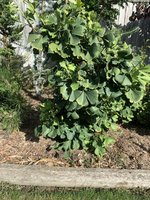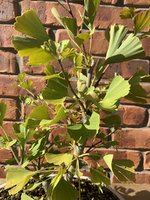KiwiPlantGuy
Omono
Hi all,
I thought I would start a new thread to document my couple of Ginkgo trees.
Although the pot is too large for this tree below, I thought I would use it to see how to grow Ginkgo in a flat bonsai pot.
As you can see from my photos I have a concern about the soil mix I am using which is great for most of the other trees I am growing.
The mix I am using for this and my maples is 2 part Pumice, 1 part Scoria (lava), and 1 part Zeolite. I know that Ginkgo like quite a high pH but I thought both the Scoria and the Zeolite were alkaline enough.
Am I worrying too much about the leaf colour? And which deficiency is this showing?
Tagging @Leo in N E Illinois , @Bonsai Nut , and @0soyoung for their thoughts/help.
Late Summer here if that wasn’t obvious enough!
And a photo of my other Ginkgo happily growing in my garden (pH 6 ish)

Charles
I thought I would start a new thread to document my couple of Ginkgo trees.
Although the pot is too large for this tree below, I thought I would use it to see how to grow Ginkgo in a flat bonsai pot.
As you can see from my photos I have a concern about the soil mix I am using which is great for most of the other trees I am growing.
The mix I am using for this and my maples is 2 part Pumice, 1 part Scoria (lava), and 1 part Zeolite. I know that Ginkgo like quite a high pH but I thought both the Scoria and the Zeolite were alkaline enough.
Am I worrying too much about the leaf colour? And which deficiency is this showing?
Tagging @Leo in N E Illinois , @Bonsai Nut , and @0soyoung for their thoughts/help.
Late Summer here if that wasn’t obvious enough!

And a photo of my other Ginkgo happily growing in my garden (pH 6 ish)

Charles


